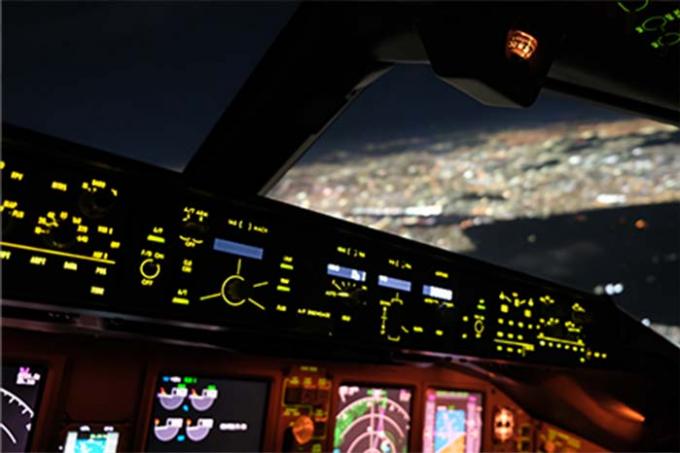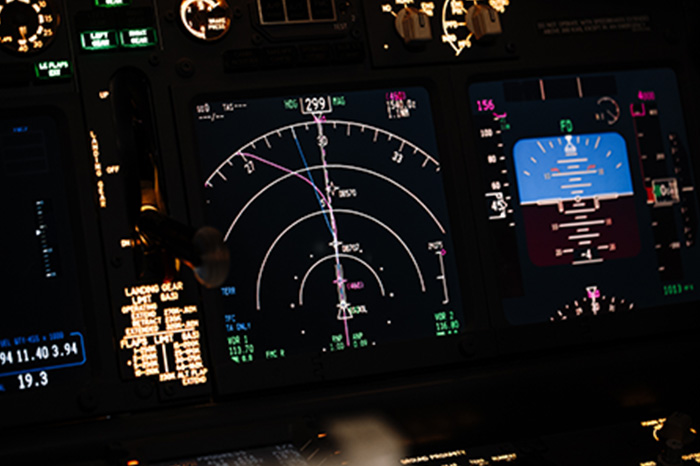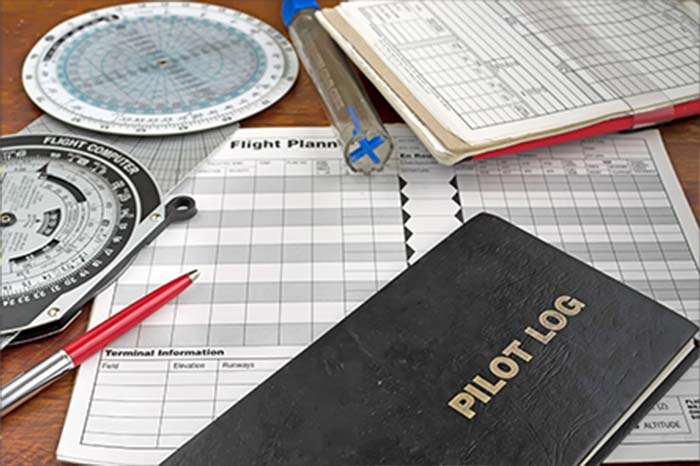

Student doing Approach Procedure ( Source Picture : Freepik/EyeEm)
Instrument approaches refer to procedures that allow pilots to land safely when visual references like the runway or surrounding terrain are not visible due to weather conditions. These approaches rely on instruments and navigation aids to guide pilots to the runway. The types of instrument approaches vary based on the available navigation aids and the level of precision required for the landing.
There are two main types of instrument approaches: precision approaches and non-precision approaches. Understanding these types is crucial for any pilot flying under IFR.
Precision approaches provide both lateral and vertical guidance to the runway, making them the most accurate approach type. The most common precision approach is the Instrument Landing System (ILS), which helps pilots align with the runway in poor visibility. Precision approaches have specific minimum conditions that must be met for the approach to continue safely.
Non precision approaches provide only lateral guidance, meaning they help pilots align with the runway without vertical descent information. Examples include VOR (VHF Omnidirectional Range) and RNAV (Area Navigation) approaches. Pilots performing non-precision approaches must be especially vigilant about altitude, as these approaches do not offer precise descent guidance like precision approaches do.

Boeing 737 Navigation Display ( Source Picture : Freepik/maximdenisenko)
Performing an instrument approach involves multiple steps that require thorough preparation, precise navigation, and close coordination with air traffic control (ATC). Since instrument approaches are often executed in poor weather or low-visibility conditions, it's essential that pilots follow the established procedures carefully. Let’s break down the key steps in the process:
Before beginning the approach, the pilot must review the approach plate. This chart contains crucial details about the specific instrument approach the pilot will be flying, including:
Navigation Aids: Information on the radio frequencies and waypoints that guide the approach.
Missed Approach Procedures: Instructions on what to do if the pilot cannot land and needs to abort the approach.
Weather Minimums: The minimum visibility or ceiling required for the approach to be flown legally.
Pilots study the chart to understand how the approach will be flown and what to expect during each phase. This briefing is critical for making sure the pilot is fully aware of the necessary actions and potential hazards.
The next step is to configure the aircraft for the approach. This involves completing an approach checklist to ensure that all systems are functioning correctly. Key items include:
Setting Navigation Radios: Tuning in the proper frequencies for ground-based navigation aids like ILS, VOR, or RNAV.
Selecting Approach Mode on the Autopilot: If the aircraft is equipped with an autopilot, the pilot selects the correct mode to assist in flying the approach.
Configuring the Aircraft: Ensuring the landing gear is extended, flaps are set correctly, and speeds are appropriate for the approach and landing.
Completing this checklist ensures that everything is ready before the descent begins.
Throughout the instrument approach, pilots must remain in close communication with ATC. The controller will provide vectors (course directions) to help guide the aircraft to the initial approach fix (IAF) and clear the pilot for the approach.
During the approach, ATC can provide updated information on weather conditions, traffic, and any changes that may affect the approach. Pilots rely on these instructions to stay aligned with the approach path and to know whether the conditions are safe to continue descending toward the runway.
As the approach progresses, pilots must follow the instructions on the approach plate, adjusting their altitude, heading, and speed as required. They use instruments like the glide slope (for precision approaches) and localizer or GPS (for both precision and non-precision approaches) to stay on the correct approach path.
The successful completion of an instrument approach requires constant attention to the instruments, frequent cross-checks of the aircraft’s position, and quick decision making in response to changes in weather or ATC instructions.
An instrument approach is broken down into four main segments, each with specific roles and responsibilities for the pilot. These segments help guide the aircraft from the enroute phase to a safe landing, or, if necessary, a missed approach.
The initial approach segment begins at the Initial Approach Fix (IAF), which is the starting point for the approach procedure. In this segment, the pilot transitions from the enroute portion of the flight to the approach phase. The goal here is to position the aircraft correctly for entry into the intermediate segment.
Key aspects of the initial approach segment:
Establishing Direction: Pilots use navigational aids or GPS waypoints to align themselves with the approach path.
Descent: If required, the pilot may begin descending to an altitude that is appropriate for the intermediate segment.
Distance Management: Pilots must manage speed and distance to ensure they can transition smoothly to the intermediate approach segment.
The intermediate approach segment begins at the Intermediate Fix (IF) and is designed to position the aircraft for a stable descent on the final approach. This segment helps fine-tune the alignment of the aircraft with the runway or approach course.
In this segment:
Speed Control: Pilots will typically slow the aircraft to the appropriate approach speed, preparing for the final descent.
This segment ensures that the aircraft is on the correct path and at the right altitude to begin the final descent to the runway.
The final approach segment is the most critical part of the instrument approach. It begins when the aircraft is aligned with the runway (or the approach path for a circling approach) and continues until the aircraft reaches the Decision Height (DH) or Minimum Descent Altitude (MDA).
Precision Approach Procedures: In a precision approach (like ILS), the pilot follows both lateral (localizer) and vertical (glide slope) guidance to stay aligned with the runway centerline and descend at the correct rate.
Non Precision Approach Procedures: In a non-precision approach, pilots follow only lateral guidance (such as VOR or RNAV) and must monitor their altitude manually.
Decision Height or MDA: As the aircraft approaches the runway, the pilot reaches a decision point, either a Decision Height (for precision approaches) or Minimum Descent Altitude (for non-precision approaches). At this point, the pilot must either have visual contact with the runway to continue the landing or execute a missed approach.
This segment requires maximum focus from the pilot, as it involves a transition from instrument flight to visual flight just before landing.
If the pilot cannot see the runway or if the conditions do not meet the required minimums at DH or MDA, they must initiate the missed approach procedure. This procedure is designed to ensure the aircraft climbs safely away from the runway and transitions to either another attempt or diversion to an alternate airport.
Climb to Safe Altitude: The pilot must execute a controlled climb to a safe altitude to avoid terrain and obstacles.
Follow Missed Approach Instructions: The approach plate provides specific instructions for the missed approach, including direction, altitude, and navigation aids to use.

Pilot Logbook ( Source Picture : Freepik/gabrielemaltinti)
Maintaining IFR currency is essential for pilots who frequently perform instrument approaches. Without regular practice, pilots may lose proficiency and fail to meet the necessary minimums for safe IFR flight. To stay current, pilots must complete a certain number of instrument approaches within a specified period. This ensures they are prepared for real-world scenarios where precision is required.
According to FAA regulations, pilots must perform at least six instrument approaches every six months to maintain IFR currency. These approaches can be completed in real flight conditions or in an approved flight simulator.
For a pilot to legally begin an instrument approach, the weather must meet the published minimums for that particular approach. If the weather deteriorates below these minimums during the approach, the pilot must be ready to execute the missed approach procedure
As a pilot, you need to be equipped with the knowledge and skills to safely perform instrument approaches in various conditions. Our 10 Day Accelerated Instrument Rating Program is designed to help you master the techniques and procedures for both precision and non-precision approaches. Gain in depth knowledge and have fun while learning, enroll in our program today and elevate your piloting skills!
Take the next step in your flying journey and confidently perform instrument approaches in any weather! Check out our Instrument Rating Program and start mastering your approach techniques now!

Instrument approaches are essential for pilots flying under Instrument Flight Rules (IFR), especially when weather conditions reduce visibility. Mastering various types of instrument approaches ensures that pilots can safely navigate and land in low-visibility conditions. In this article, we’ll explore the types of instrument approaches, the techniques pilots use, and the key segments of an instrument approach, while focusing on maintaining IFR currency.

Student doing Approach Procedure ( Source Picture : Freepik/EyeEm)
Instrument approaches refer to procedures that allow pilots to land safely when visual references like the runway or surrounding terrain are not visible due to weather conditions. These approaches rely on instruments and navigation aids to guide pilots to the runway. The types of instrument approaches vary based on the available navigation aids and the level of precision required for the landing.
There are two main types of instrument approaches: precision approaches and non-precision approaches. Understanding these types is crucial for any pilot flying under IFR.
Precision approaches provide both lateral and vertical guidance to the runway, making them the most accurate approach type. The most common precision approach is the Instrument Landing System (ILS), which helps pilots align with the runway in poor visibility. Precision approaches have specific minimum conditions that must be met for the approach to continue safely.
Non precision approaches provide only lateral guidance, meaning they help pilots align with the runway without vertical descent information. Examples include VOR (VHF Omnidirectional Range) and RNAV (Area Navigation) approaches. Pilots performing non-precision approaches must be especially vigilant about altitude, as these approaches do not offer precise descent guidance like precision approaches do.

Boeing 737 Navigation Display ( Source Picture : Freepik/maximdenisenko)
Performing an instrument approach involves multiple steps that require thorough preparation, precise navigation, and close coordination with air traffic control (ATC). Since instrument approaches are often executed in poor weather or low-visibility conditions, it's essential that pilots follow the established procedures carefully. Let’s break down the key steps in the process:
Before beginning the approach, the pilot must review the approach plate. This chart contains crucial details about the specific instrument approach the pilot will be flying, including:
Navigation Aids: Information on the radio frequencies and waypoints that guide the approach.
Missed Approach Procedures: Instructions on what to do if the pilot cannot land and needs to abort the approach.
Weather Minimums: The minimum visibility or ceiling required for the approach to be flown legally.
Pilots study the chart to understand how the approach will be flown and what to expect during each phase. This briefing is critical for making sure the pilot is fully aware of the necessary actions and potential hazards.
The next step is to configure the aircraft for the approach. This involves completing an approach checklist to ensure that all systems are functioning correctly. Key items include:
Setting Navigation Radios: Tuning in the proper frequencies for ground-based navigation aids like ILS, VOR, or RNAV.
Selecting Approach Mode on the Autopilot: If the aircraft is equipped with an autopilot, the pilot selects the correct mode to assist in flying the approach.
Configuring the Aircraft: Ensuring the landing gear is extended, flaps are set correctly, and speeds are appropriate for the approach and landing.
Completing this checklist ensures that everything is ready before the descent begins.
Throughout the instrument approach, pilots must remain in close communication with ATC. The controller will provide vectors (course directions) to help guide the aircraft to the initial approach fix (IAF) and clear the pilot for the approach.
During the approach, ATC can provide updated information on weather conditions, traffic, and any changes that may affect the approach. Pilots rely on these instructions to stay aligned with the approach path and to know whether the conditions are safe to continue descending toward the runway.
As the approach progresses, pilots must follow the instructions on the approach plate, adjusting their altitude, heading, and speed as required. They use instruments like the glide slope (for precision approaches) and localizer or GPS (for both precision and non-precision approaches) to stay on the correct approach path.
The successful completion of an instrument approach requires constant attention to the instruments, frequent cross-checks of the aircraft’s position, and quick decision making in response to changes in weather or ATC instructions.
An instrument approach is broken down into four main segments, each with specific roles and responsibilities for the pilot. These segments help guide the aircraft from the enroute phase to a safe landing, or, if necessary, a missed approach.
The initial approach segment begins at the Initial Approach Fix (IAF), which is the starting point for the approach procedure. In this segment, the pilot transitions from the enroute portion of the flight to the approach phase. The goal here is to position the aircraft correctly for entry into the intermediate segment.
Key aspects of the initial approach segment:
Establishing Direction: Pilots use navigational aids or GPS waypoints to align themselves with the approach path.
Descent: If required, the pilot may begin descending to an altitude that is appropriate for the intermediate segment.
Distance Management: Pilots must manage speed and distance to ensure they can transition smoothly to the intermediate approach segment.
The intermediate approach segment begins at the Intermediate Fix (IF) and is designed to position the aircraft for a stable descent on the final approach. This segment helps fine-tune the alignment of the aircraft with the runway or approach course.
In this segment:
Speed Control: Pilots will typically slow the aircraft to the appropriate approach speed, preparing for the final descent.
This segment ensures that the aircraft is on the correct path and at the right altitude to begin the final descent to the runway.
The final approach segment is the most critical part of the instrument approach. It begins when the aircraft is aligned with the runway (or the approach path for a circling approach) and continues until the aircraft reaches the Decision Height (DH) or Minimum Descent Altitude (MDA).
Precision Approach Procedures: In a precision approach (like ILS), the pilot follows both lateral (localizer) and vertical (glide slope) guidance to stay aligned with the runway centerline and descend at the correct rate.
Non Precision Approach Procedures: In a non-precision approach, pilots follow only lateral guidance (such as VOR or RNAV) and must monitor their altitude manually.
Decision Height or MDA: As the aircraft approaches the runway, the pilot reaches a decision point, either a Decision Height (for precision approaches) or Minimum Descent Altitude (for non-precision approaches). At this point, the pilot must either have visual contact with the runway to continue the landing or execute a missed approach.
This segment requires maximum focus from the pilot, as it involves a transition from instrument flight to visual flight just before landing.
If the pilot cannot see the runway or if the conditions do not meet the required minimums at DH or MDA, they must initiate the missed approach procedure. This procedure is designed to ensure the aircraft climbs safely away from the runway and transitions to either another attempt or diversion to an alternate airport.
Climb to Safe Altitude: The pilot must execute a controlled climb to a safe altitude to avoid terrain and obstacles.
Follow Missed Approach Instructions: The approach plate provides specific instructions for the missed approach, including direction, altitude, and navigation aids to use.

Pilot Logbook ( Source Picture : Freepik/gabrielemaltinti)
Maintaining IFR currency is essential for pilots who frequently perform instrument approaches. Without regular practice, pilots may lose proficiency and fail to meet the necessary minimums for safe IFR flight. To stay current, pilots must complete a certain number of instrument approaches within a specified period. This ensures they are prepared for real-world scenarios where precision is required.
According to FAA regulations, pilots must perform at least six instrument approaches every six months to maintain IFR currency. These approaches can be completed in real flight conditions or in an approved flight simulator.
For a pilot to legally begin an instrument approach, the weather must meet the published minimums for that particular approach. If the weather deteriorates below these minimums during the approach, the pilot must be ready to execute the missed approach procedure
As a pilot, you need to be equipped with the knowledge and skills to safely perform instrument approaches in various conditions. Our 10 Day Accelerated Instrument Rating Program is designed to help you master the techniques and procedures for both precision and non-precision approaches. Gain in depth knowledge and have fun while learning, enroll in our program today and elevate your piloting skills!
Take the next step in your flying journey and confidently perform instrument approaches in any weather! Check out our Instrument Rating Program and start mastering your approach techniques now!
Ilham Febrian is a dedicated aviation blogger with a strong interest and high expectations for the aviation industry. He holds a DGCA Commercial Pilot license with Airbus A320 type rating. Continuously updated with the latest aviation news, Ilham strives to provide top-quality content on the website, aimed at assisting all pilots. The website focuses on offering flight training guidance, information on flying school materials, and tips on how students can successfully pass their check rides.
Ilham Febrian is a dedicated aviation blogger with a strong interest and high expectations for the aviation industry. He holds a DGCA Commercial Pilot license with Airbus A320 type rating. Continuously updated with the latest aviation news, Ilham strives to provide top-quality content on the website, aimed at assisting all pilots. The website focuses on offering flight training guidance, information on flying school materials, and tips on how students can successfully pass their check rides.